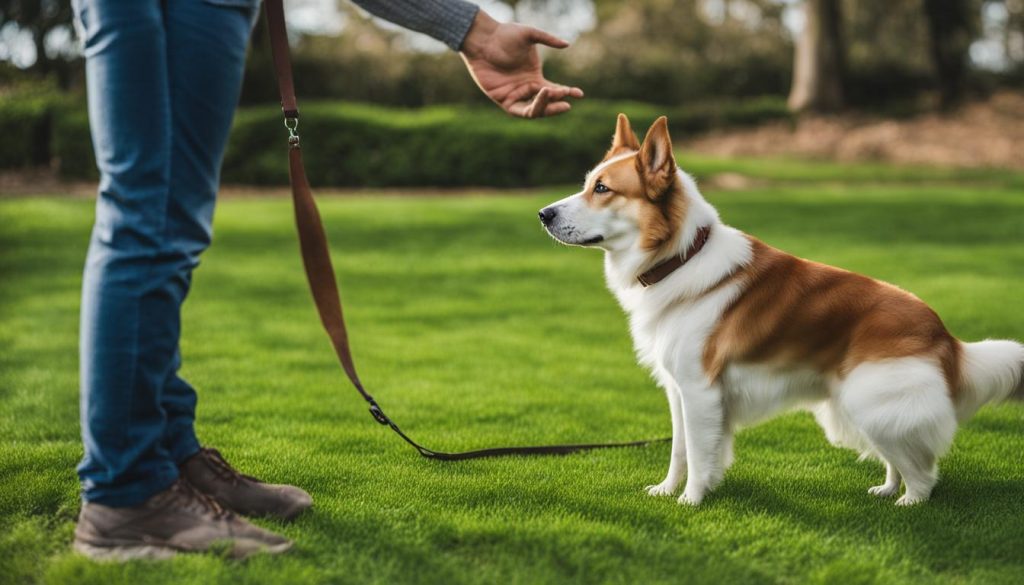Teaching a dog to stay is a critical but often challenging aspect of dog training. A well-defined “Stay” command requires you to follow specific steps, working backward to achieve more extended and more reliable stays. In this guide, I will provide you with essential advice and techniques to make the stay command an integral part of your dog’s training repertoire. By understanding the Three D’s: Duration, Distance, and Distractions, you can balance each element, ensuring your dog’s stay command is reliable no matter what is happening around them.
How to Teach a Dog to Stay
- Start by teaching your dog the release word and the stay command
- Build duration in increments, gradually adding time to the stay
- Introduce distance training, stepping away from the dog while they hold the stay, and returning before releasing them
- Incorporate distractions only after mastering duration and distance
- Practice consistency and patience during the training process
- Proof your dog’s stay command by working on their focus amidst distractions and distances
- Track and assess your dog’s progress to ensure success in their stay command
Understanding the Basics of Stay Training for Dogs
When it comes to teaching your dog to stay, establishing a clear structure is essential. This includes specific start and end signals, so your dog understands when to hold the stay position. A unique release word differentiates the “Stay” command from other behaviors, reinforcing the desired action. By starting with short stay durations and gradually introducing distance and distractions, you lay the groundwork for stay training for dogs.
One of the critical steps to train a dog to stay is creating a strong foundation by emphasizing the importance of the release word. This word should be distinct from your usual commands and used consistently throughout the training process. The release word serves as a signal for your dog to break the stay position, allowing them to understand the difference between a temporary pause and a full stop.
Begin your stay training by working on duration. Start with brief periods, such as a few seconds, and reward your dog for maintaining the stay position. Gradually increase the duration as your dog becomes more comfortable and successful with the command. By consistently rewarding your dog for staying put even for short intervals, you’ll reinforce their understanding of the “Stay” command.
As your dog masters duration, you can begin incorporating distance into the stay training. Start by taking a single step away from your dog, rewarding them for maintaining their position. Gradually increase the distance between you and your dog as they demonstrate proficiency with the command.
Finally, introduce distractions to your stay training. Begin with mild distractions, such as a toy placed near your dog or someone walking by. As your dog learns to ignore these distractions, you can gradually introduce more challenging stimuli. This process will help your dog develop the ability to stay put, regardless of what’s happening around them.
In summary, understanding the basics of stay training for dogs requires establishing a clear structure with specific start and end signals, a unique release word, and gradual progression through duration, distance, and distractions. Building this strong foundation will help your dog become more confident and capable of executing the “Stay” command in various situations.
Steps to Train a Dog to Stay with Confidence
Training your dog to stay with confidence requires a combination of patience, consistency, and progression through a series of steps aimed at building a solid foundation in obedience and focus. In this section, we will discuss various techniques and strategies for successfully teaching your dog the stay command, as well as incorporating the three D’s – duration, distance, and distractions – in your training routine.
Initiating the Stay Command
To initiate the stay command, start by teaching your dog a specific release word immediately after issuing the stay command. This will help them understand when the command ends. Use non-verbal cues, such as stepping back or positive reinforcement in the form of praise or treats, to encourage movement once you give the release word. In the initial stages, it is vital to reward your dog when they successfully complete the stay and release sequence.
Incorporating the Three D’s in Stay Training: Duration, Distance, and Distractions
One of the most effective techniques for teaching stay command to dogs is to gradually introduce the three D’s (duration, distance, and distractions) in their training sessions. Start by training your dog to stay for short durations and progressively increase the time as they succeed. For distance training, take small steps away from the dog while they are in the stay position, always ensuring you return to them before using the release word.
Introducing distractions should only come after your dog has built a solid foundation in duration and distance training. Use high-value treats or toys as distractions and implement commands like “leave it” to help your dog maintain focus on the stay command amidst various distractions.
Practicing Consistency and Patience
Consistency and patience play a critical role in successfully teaching stay to your new dog. Use a single release word and be mindful of your body language to avoid inadvertently luring the dog into breaking the stay command prematurely. Setting realistic expectations will also help smoothen the training process.
It is essential to reward the stay behavior itself, not the release. This will highlight the importance of holding the stay position to your dog. As a key component of dog training stay command, be prepared to set aside ample time and maintain a positive attitude throughout the process. With patience and persistence, your dog’s understanding and performance of the stay command will steadily improve over time.
Effective Techniques for Teaching Stay Command to Dogs

Training your dog to reliably obey the stay command involves several essential dog training techniques. By crafting a definitive beginning and ending to the stay command and integrating proofing for distractions and distance, you can achieve a well-trained and obedient canine companion.
Crafting a Definite Beginning and Ending
Establishing a clear start and end for the stay command is crucial for preventing confusion and ensuring success. Begin by positioning your dog and issuing a clear stay command. Immediately follow the command with a release word, signaling to your dog that the stay has ended. Frequent rewards and positive interactions after releasing your dog will reinforce the importance of the stay command and its cycle.
One essential tip to remember is not to use the recall command from the stay position. Doing so can inadvertently encourage your dog to break the stay prematurely, causing setbacks in training progress. Consistently sticking to a unique release word will help your dog differentiate between commands and understand precisely when it is allowed to break the stay.
Integrating Proofing for Distraction and Distance
To ensure your dog’s stay command remains reliable amidst various distractions and distances, proofing is an indispensable technique. Begin by gradually increasing the difficulty level of distractions your dog encounters during stay training. You can also vary your presence and actions during training sessions to challenge your dog further and strengthen its ability to maintain the stay command.
When your dog has mastered basic distraction and distance proofing, you can utilize additional training tools such as mirrors to maintain sight during out-of-view exercises. In situations where temptations are present, employing auxiliary commands like “leave it” can be beneficial in reiterating the importance of staying put.
By implementing these effective techniques for teaching the stay command to dogs, you will enhance your dog’s discipline and responsiveness in various situations. With patience, consistency, and proper training methods, your dog will soon master the art of the stay command.
Advanced Training Tips for Teaching Stay to Your New Dog
Once your dog has grasped the basics of the stay command, it’s time to incorporate advanced training tips for teaching stay to your new dog. Building on the foundation already established, these advanced techniques focus on gradually increasing the time, distance, and adding distractions at a manageable pace. This leads to improved reliability and adherence to the advanced dog stay command in various conditions and environments.
Start by increasing the duration of your dog’s stay incrementally. Aim for a mix of shorter stays and occasional longer stays to encourage your dog to remain attentive. Always be ready to reward your dog for successfully holding their stay position longer than usual, as this reinforces the desired behavior and motivates them to keep improving.
When incorporating distance into the advanced dog stay command, remember to increase the distance at a steady and gradual pace. By moving further away from your dog during their stay, they learn to remain in place even when you are not physically close, allowing you to maintain control from a distance.

As you progress, introduce various distractions to test your dog’s ability to stay despite external stimuli. Use toys, other animals, or people to gradually raise the difficulty level. Always reward your dog for maintaining their stay amidst the distractions, as this positively reinforces their behavior.
However, should your dog struggle with maintaining the stay or break the command prematurely, it is essential to regress to a previously successful stage and slowly build back up. This adaptive approach encourages stronger adherence to the stay command as the difficulty increases, while also preventing your dog from becoming discouraged or overwhelmed.
In conclusion, advanced training tips for teaching stay to your new dog involve building on the established foundation in duration, distance, and distractions. By remaining patient, consistent, and adaptive to your dog’s needs as you progress, you will strengthen your dog’s stay command and increase its effectiveness in more challenging situations.
READ: Tips on How to Train a Deaf Dog: A Guide
Conclusion
Teaching your dog to stay is a vital skill that requires patience, consistency, and a thorough understanding of the process. By measuring dog training progress, tailoring your approach, and celebrating your dog’s accomplishments, you will develop a solid foundation for your dog’s stay command. It is essential to keep track of your dog’s performance with regards to duration, distance, and distractions to ensure a steady advancement in their training.
To achieve dog stay command success, adjust the training method based on your dog’s individual needs and response. By carefully monitoring your dog’s progress through various stages of training, you will solidify their understanding of the command and strengthen their ability to perform the stay even in challenging situations.
In conclusion, assessing dog stay training periodically is crucial for a well-executed and reliable stay command. By investing time and effort into teaching your dog to stay, you will enhance your bond with your furry friend, improve their overall obedience, and ultimately ensure a happy, well-trained companion. Remember, progress may vary depending on the dog’s breed, age, and personality, so keep patient and maintain a tailored approach for the best results.
FAQ
What are the essential commands for dog training?
Some essential commands for dog training include “sit,” “stay,” “come,” “down,” “heel,” and “leave it.” These commands provide a basis for obedience and help maintain control over your dog in various situations.
How do I initiate the stay command for my dog?
To initiate the stay command, begin by positioning your dog and giving a clear stay command, followed by a unique release word. This signals the beginning and end of the command. Use positive reinforcement and non-verbal cues, such as stepping back, to encourage movement after the release word.
What are the Three D’s in dog stay training?
The Three D’s in dog stay training are Duration, Distance, and Distractions. Duration refers to the length of time your dog can maintain the stay command, Distance refers to the space between you and your dog during the stay, and Distractions are external factors that may cause your dog to break the stay. Balancing the Three D’s is essential for developing a reliable stay command.
How do I effectively teach my dog the stay command while incorporating distractions?
Introducing distractions should come after a solid foundation in duration and distance. Use high-value treats and commands like “leave it” to maintain your dog’s focus. Gradually increase the level of distractions while monitoring their progress and adjusting as needed. Auxiliary commands like “leave it” can help reinforce the stay amidst temptations.
How do I measure my dog’s progress and success with the stay command?
To measure your dog’s progress and success with the stay command, keep track of the duration of their stay, distance achieved, and the distractions they can handle. Adjust your training approach based on your dog’s individual response and consistently assess their performance to ensure they can execute the stay command reliably in various situations.






